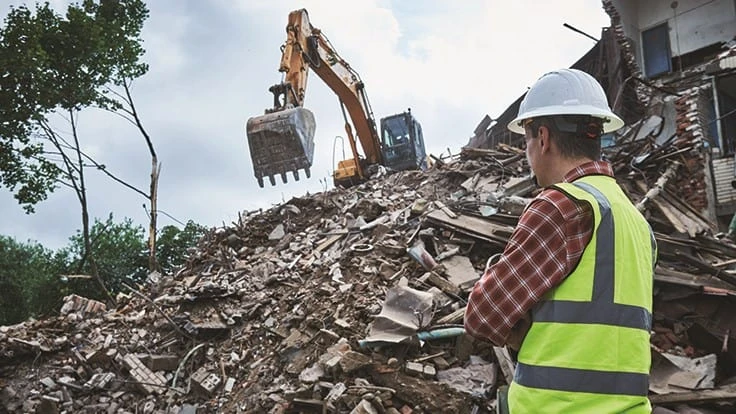Every demolition project comes with inherent risks. To help understand and mitigate these challenges, the National Demolition Association (NDA) created its Foundations of Demolition Risk Management course for industry professionals. Tim Barker, D4 program director at Los Angeles-based AECOM, helped devise the program and currently serves as one of its instructors.
Barker talked to Construction & Demolition Recycling (C&DR) about the program and how its curriculum is constructed to cover an array of issues that might arise on a project.
C&DR: What types of risks does this class address?
Tim Barker (TB): The class focuses on commercial as well as technical risks. These risks can range from safety, environmental and public relations risks, to hedging against scrap price fluctuations, and so on. So, with commercial risk, we would talk about contracts and what type of risks contractors are taking on when they sign up for a job, whether that relates to a Hold Harmless agreement, indemnification or insurance issues and how they pass that risk down to their subcontractors and vendors or maybe negotiate some of that risk with the owners.
So, we talk about all those commercial risks, and then we spend the other half of the class talking about the technical risks. These are very high-level discussions because you have environmental risks, demolition risks, public relations risks, and we talk about all that at length.
C&DR: Who is this class for?
TB: We have demolition and abatement contractors, owners, engineers, architects—this class is really for everyone. For anyone involved in a large-scale decommissioning project, there’s going to be risk, and this course is going to be of great value to them in helping understand how to identify and manage that risk.
C&DR: How do you go about teaching contractors to rank and determine risk?
TB: The typical risk management approach incorporates what we call a risk register. Fundamentally, the objective of the risk management course is to teach contractors how to develop a risk register and get participants to think about all the various risks associated with a demolition project and how they’re going to mitigate them.
This risk register helps contractors examine individual risks and rank them on a scale of 1-5, with 5 being the highest, based upon both the probability and severity of that risk. And then you multiply the two numbers to help you determine what’s your greatest risk. Obviously, you want to spend a greater amount of time coming up with ways to mitigate the greatest risks. So, if a particular risk has a rank of 5 for probability and 5 for severity, you multiply those numbers together to get a score of 25, which means it is extremely high risk. Conversely, if something has a high probability of 5 but the severity is low and only ranks a 1 on the scale, it might be in the low-risk range.
You identify your risks and you color-code them red, yellow or green with the same meaning as a stop light. If the risk is in the red, let’s stop, let’s take a look at it and not move forward until we come up with some approaches to mitigate or manage that risk. If it’s yellow, we might not stop, but we’re going to pause our activity and we’re going to talk about the issue. If it’s green, we’re not going to completely ignore the issue, but we’re maybe not going to have a sit-down session to really evaluate it in great detail. Anything 7 and below is probably green. I say, “probably,” because there is some argument in the industry as to what constitutes risk in that yellow category, but I would say from 7 to 8 to around 18 is that medium risk that you want to talk about, and then anything above that is in the red category and merits immediate attention.
C&DR: How should companies go about discussing these risks?
TB: Risks, as we classify them, are different than work-site hazards. Hazards are something you identify on a job site that you see might be dangerous and you stop and take action right away. The risk register is a living document meant to evaluate a range of items. Risks that you’ve identified at the beginning of the project may remain until the end of the project. You may not be able to get a high-level red risk down to yellow, but you put some extra focus on it and you make sure that you manage that risk and that you revisit that risk register. Maybe if it’s pertaining to an on-site environmental risk issue, you’re evaluating this on a daily or weekly basis. If the risk relates to an off-site management issue, maybe it’s on a monthly basis. If you’re the general manager, maybe you sit down with your project managers and take a monthly or biweekly look at the risk registers. Often, owners will engage contractors to identify, assess and mitigate risk on their overall project risk register. Regardless, these are meant to be living documents that are continually evaluated. In the end, what gets focused on is what gets addressed, and that’s what this course is all about.






